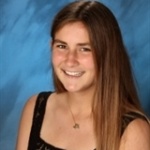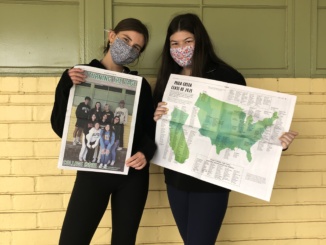
Clare Beezhold
Staff Writer
Teresa Hubbard and Alexander Birchler’s exhibit “Flora” provides viewers with an explanation as to why the sculptor Flora Mayo was excluded from art history.
In this exhibit, artists Teresa Hubbard and Alexander Birchler reveal the often heartbreaking story of Mayo’s life in a 30 minute film titled “Flora.” Using a two-channel video projected onto opposing sides of a large screen, viewers see Flora Mayo’s life through the lens of her son, David, as well as a fictional reimagining of the artist’s life as portrayed by a look-alike actress. While the soundtrack remains a constant, by the use of a double-sided film installation the viewer gains two different perspectives on Mayo’s life. One is told through a conversation between mother and son and the other through a conversation between Mayo and her famous lover, sculptor Alberto Giacometti, who is one of the most celebrated artists of the 20th century.
In the films, societal expectations imposed on women of Mayo’s time are revealed to the viewer; including before, during and after the Great Depression. Mayo, born in Denver, Colorado to a wealthy family, was pushed into an arranged and loveless marriage at the age of nineteen. Once she got divorced, Mayo took off to New York where she began taking art classes at Art Students League. Then at age twenty-five she left for Paris where she enrolled in classes at Academie de la Grande Chaumiere. It is here that Mayo met and fell in love with fellow sculptor Alberto Giacometti. In both New York and Paris, Mayo was financially supported by her family. This all changed, however, when Mayo’s family lost their fortune in the Great Depression. As a result, an impoverished Mayo returned to America where she began a life in California.
The exhibit is centered around the moving film that has been created to inform the viewer of Mayo’s life from two different lens. The first lens is a current and colored film that includes the interview of her son, David, and the family photos he has of his mother. The second lens is a black and white reimagining of the time Mayo spent in Paris creating a sculpture of her lover Giacometti, and dealing with the grief that came along with losing access to her child. The two films are sewn together perfectly with their matching soundtrack; which is fitting for a women of her talent.
Outside of the dark screening room there is a small walkway which includes a recreation of one of Mayo’s destroyed works, a bust, which is a type of sculpture, that was so eloquently sculpted of Mayo’s lover Giacometti. Also captured in this area is the photo taken from Giacometti’s biography, which servesb as evidence of Mayo and Giacometti’s relationship. The recreated bust brings to life the amazing talent that Mayo possessed.
The retelling of Mayo’s life from David’s perspective marks what Hubbard and Birchler call the “missing puzzle piece” needed to expand Mayo’s life story. As only David can, he provides the viewer an overview of Mayo’s privileged beginnings as a member of a wealthy family and the life she lead in California after she left Paris. Prior to discovering David’s existence, Hubbard and Bichler had only been able to learn fleeting details of Mayo’s life while living in Paris.
On the opposing screen, in the fictional reimagining of Mayo’s life, the viewer gains glimpses of a young and happy Mayo as she painstakingly creates the bust of her lover, Alberto Giacometti. To avoid viewers from thinking Mayo’s life in Paris is carefree, there are also scenes which capture what Mayo left behind in Denver and her economic instability.
Whether you are an art lover, a history buff, or neither anyone who has an interest in re-discovering a talented but forgotten artist, you should hit the mid-cities district to see this exhibit. After taking in this double-sided film installation, you will walk away happy in the knowledge that Mayo’s dream of becoming an artist is indeed true.
The Teresa Hubbard and Alexander Birchler’s “Flora” and “Bust” is currently on exhibit at LACMA January 20th through April 7. For more information regarding this and future exhibits, visit www.lacma.org





Leave a Reply